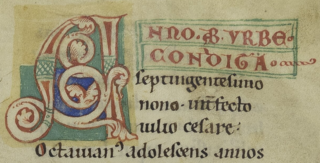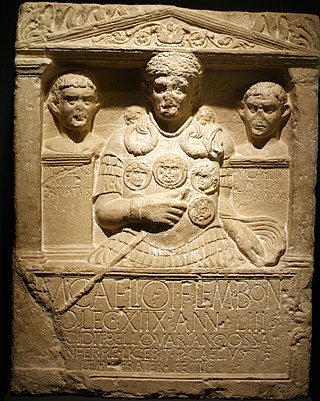
Ab urbe condita, or anno urbis conditae, abbreviated as AUC or AVC, expresses a date in years since 753 BC, the traditional founding of Rome. It is an expression used in antiquity and by classical historians to refer to a given year in Ancient Rome. In reference to the traditional year of the foundation of Rome, the year 1 BC would be written AUC 753, whereas AD 1 would be AUC 754. The foundation of the Roman Empire in 27 BC would be AUC 727. The current year AD 2025 would be AUC 2778.

The 30s decade ran from January 1, AD 30, to December 31, AD 39.

The 40s decade ran from January 1, AD 40, to December 31, AD 49.

The 130s was a decade that ran from January 1, 130, to December 31, 139.
The 150s decade ran from January 1, 150, to December 31, 159.
The 180s decade ran from January 1, 180, to December 31, 189.

Year 1506 (MDVI) was a common year starting on Thursday of the Julian calendar.

This article concerns the period 59 BC – 50 BC.
This article concerns the period 69 BC – 60 BC.
80s BC is the time period from 89 BC – 80 BC.
Year 169 (CLXIX) was a common year starting on Saturday of the Julian calendar. At the time, it was known as the Year of the Consulship of Senecio and Apollinaris. The denomination 169 for this year has been used since the early medieval period, when the Anno Domini calendar era became the prevalent method in Europe for naming years.
The 240s decade ran from January 1, 240, to December 31, 249.
This article concerns the period 19 BC – 10 BC.
This article concerns the period 29 BC – 20 BC.

Year 244 (CCXLIV) was a leap year starting on Monday of the Julian calendar. At the time, it was known as the Year of the Consulship of Armenius and Aemilianus. The denomination 244 for this year has been used since the early medieval period, when the Anno Domini calendar era became the prevalent method in Europe for naming years.
Year 248 (CCXLVIII) was a leap year starting on Saturday of the Julian calendar. At the time, it was known as the Year of the Consulship of Philippus and Severus. The denomination 248 for this year has been used since the early medieval period, when the Anno Domini calendar era became the prevalent method in Europe for naming years.

Philip I, commonly known as Philip the Arab, was the Emperor of the Roman Empire from 244 to 249. After the death of Gordian III in February 244, Philip, who had been Praetorian prefect, rose to power. He quickly negotiated peace with the Sasanian Empire and returned to Rome to be confirmed by the Senate.

The Equirria were two ancient Roman festivals of chariot racing, or perhaps horseback racing, held in honor of the god Mars, one 27 February and the other 14 March.

Ludi were public games held for the benefit and entertainment of the Roman people . Ludi were held in conjunction with, or sometimes as the major feature of, Roman religious festivals, and were also presented as part of the cult of state.

The 0s began on January 1, AD 1 and ended on December 31, AD 9, covering the first nine years of the Common Era. It is one of two "0-to-9" decade-like timespans that contain nine years, along with the 0s BC.











